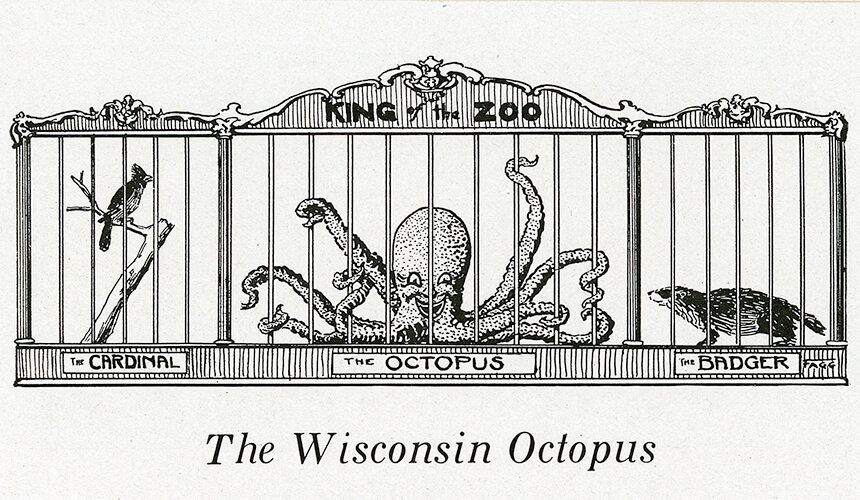The Octopus
Origins of the Octopus
In November 1919, an odd new publication began to circulate around campus. Called the Octopus, the 30-page rag cost 20 cents and was printed on seafoam-green paper. It included lengthy articles, including “A Dissertation on Chop Suey” and “From the Lit Wastebasket,” a catalogue of dreadful, pun-laden poems.

One of 12 covers James Watrous drew for the Octopus. This one is from May 1928. (Image courtesy of the UW Digital Collections Center.)
No one who saw the first issue likely would have predicted that the “Octy” would go on to become the UW’s longest-running campus humor magazine — and an incubator for some of the university’s most successful artists until it folded for good in 1959.
We don’t know what originally inspired Lowell Ragatz BA1920, MA1921, PhD1925; Marie Bodden BA1921; Frederick L. Sperry (attended 1919 to 1922); and the other founding staff members to launch the Octopus. But we do know that editor-in-chief Ragatz was already an aficionado of “fakes, forgeries, and the bogus” when he arrived at the UW after serving in World War I. Ragatz was a lifelong philatelist, or collector of stamps and other postal memorabilia, and he developed an expertise in identifying stamp forgeries. As a graduate student, Ragatz balanced the Octopus with running the Reliance Stamp Company, which he founded in 1916 under the pseudonym George van den Berg.
Though Octy’s first issue was mostly devoted to the frivolous, it wouldn’t take long for the magazine to morph into a more socially conscious publication. And like the Octy, Ragatz too had a more serious core. After leaving the UW, he became a historian. He wrote 17 books on contemporary and historical class conflicts in Europe, the United States, and the Caribbean, and he’s credited as one of the founders of African studies as a modern academic discipline. During World War II, Ragatz was a regular consultant for government agencies and held positions at the War Department and the U.S. Information Office in London, among other international assignments.
After short stints on the faculties of the University of Pennsylvania and George Washington University, Ragatz spent most of his career as a professor at Ohio State University until his death in 1978.
Peruse the first issue of the Octopus from November 1919
From the first issue of the Octopus, November 1919
Epidemic Spreads on Campus
Overrun at the present time by the demand for excuses, the clinic announces than epidemic of Examinitis is prevalent and offers the following information in regard to the malady.
The disease was first brought to light by Dr. Ella G. Bility … The symptoms are marked by a loss of appetite, a desire to sit for hours before books, yet unable to do so because of mind-wandering, and nervousness. With this, cold feet, and a numbness of the entire body, including the mental cavity is often noticed. Chills or excessive perspiration may also be present. The latter are particularly evident if the patient is asked questions, such as “who, what, when, where, etc.,” or is shown a book with a blue cover.
Unfortunately no certain remedy can be obtained once the victim is incipient. Isolation is relatively successful, for quiet and concentration relieves the nervousness, and also spread of the disease is prevented. It is highly communicable, and germs of three varieties (discouragement, anxiety, or indifference) easily infect the brain merely through conversation.
 58° F
58° F


